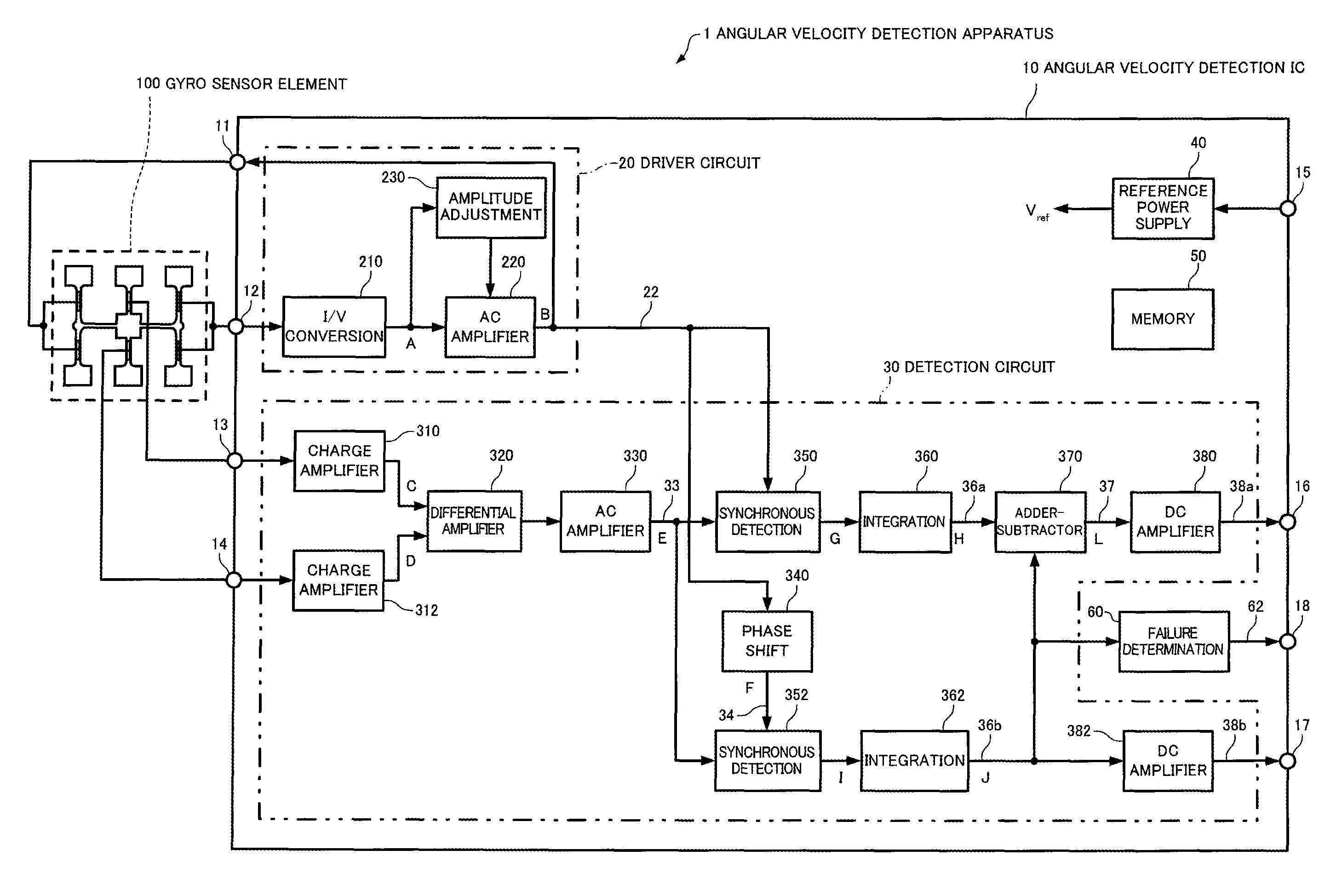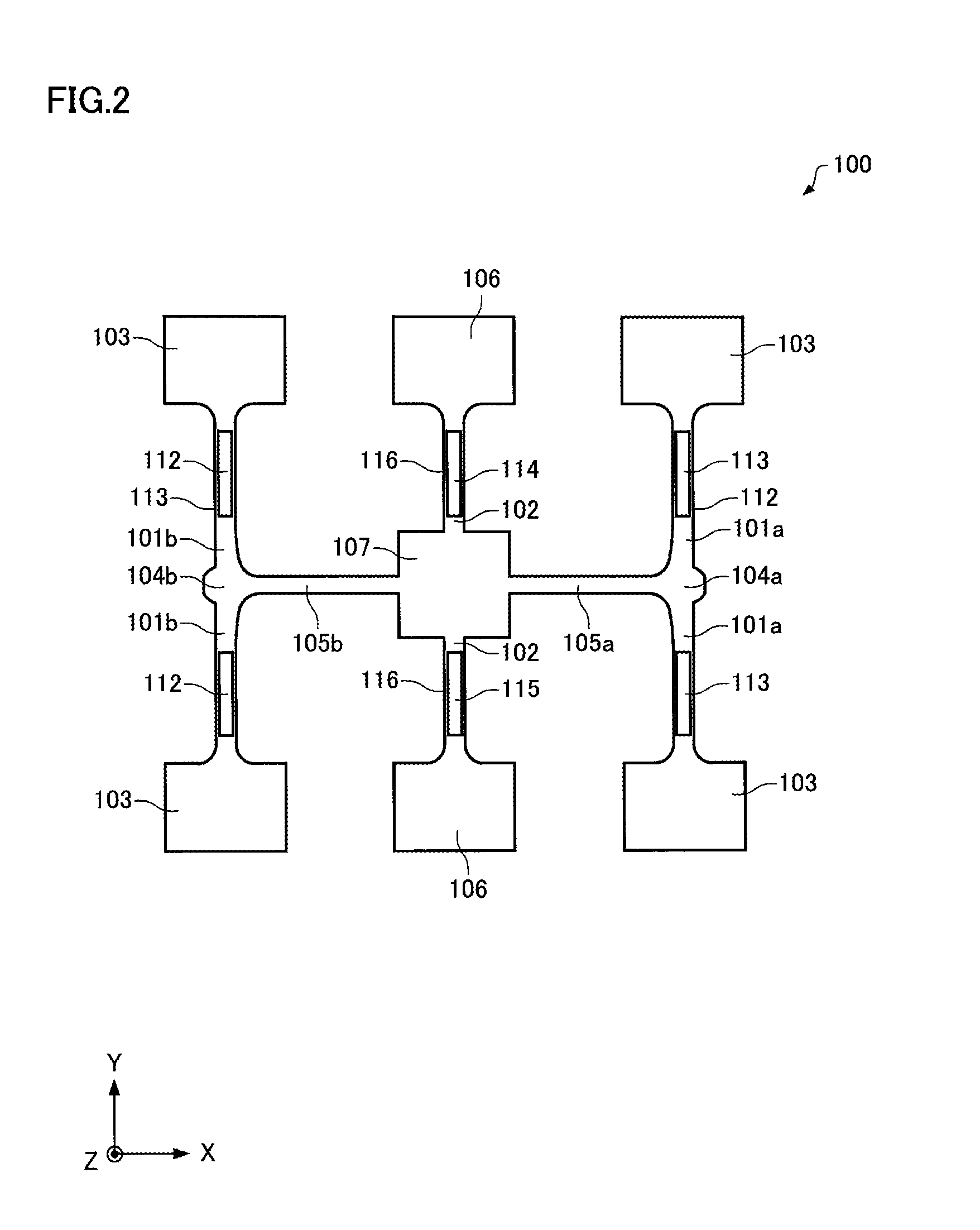Angular velocity detection apparatus and electronic instrument
a technology of angular velocity and detection apparatus, applied in the direction of acceleration measurement using interia force, turn-sensitive devices, instruments, etc., can solve problems such as wrong control of electronic instruments or systems
- Summary
- Abstract
- Description
- Claims
- Application Information
AI Technical Summary
Problems solved by technology
Method used
Image
Examples
first embodiment
1-1. First Embodiment
[0058]FIG. 1 is a diagram illustrating a configuration example of an angular velocity detection apparatus according to a first embodiment of the invention.
[0059]An angular velocity detection apparatus 1 according to the first embodiment includes a gyro sensor element 100 and an angular velocity detection IC 10.
[0060]The gyro sensor element 100 (i.e., vibrator) includes a vibrating element that includes a drive electrode and a detection electrode and is sealed in a package (not shown). The package normally has seal-tightness in order to reduce the impedance of the vibrating element to improve the vibration efficiency as much as possible.
[0061]The vibrating element of the gyro sensor element 100 may be formed of a piezoelectric material such as a piezoelectric single crystal (e.g., quartz crystal (SiO2), lithium tantalate (LiTaO3), or lithium niobate (LiNbO3)) or a piezoelectric ceramic (e.g., lead zirconate titanate (PZT)), or may have a structure in which a piez...
second embodiment
1-2. Second Embodiment
[0125]In the examples illustrated in FIGS. 7A to 7C and FIGS. 8A to 8C, the temperature characteristics of the angular velocity signal 36a is similar to the temperature characteristics of the vibration leakage signal 36b. FIG. 12 illustrates an example of temperature characteristics that differ in tendency from those illustrated in FIGS. 7A to 7C and FIGS. 8A to 8C. In FIG. 12, the horizontal axis indicates time, and the vertical axis indicates voltage. In FIG. 12, the solid line indicates the temperature characteristics of the angular velocity signal 36a, and the broken line indicates the temperature characteristics of the vibration leakage signal 36b.
[0126]In FIG. 12, the temperature characteristics of the angular velocity signal 36a and the temperature characteristics of the vibration leakage signal 36b differ in second-order component and third-order component to only a small extent, but differ in first-order component to a large extent. Therefore, the tem...
third embodiment
1-3. Third Embodiment
[0141]FIG. 16 is a diagram illustrating a configuration example of an angular velocity detection apparatus according to a third embodiment of the invention. In FIG. 16, the same sections as those illustrated in FIG. 13 are indicated by the same symbols. Description of these sections is omitted.
[0142]An angular velocity detection apparatus 1 according to the third embodiment has a configuration in which the first-order temperature adjustment circuit 390 is omitted from the configuration illustrated in FIG. 13. The first-order temperature adjustment circuit 392 adjusts the first-order component of the temperature characteristics of the vibration leakage signal 36b to approach the first-order component of the temperature characteristics of the angular velocity signal 36a based on the temperature detection signal 72. The first-order temperature adjustment circuit 392 may be configured in the same manner as in FIG. 14. The first-order temperature adjustment circuit 3...
PUM
 Login to View More
Login to View More Abstract
Description
Claims
Application Information
 Login to View More
Login to View More - R&D
- Intellectual Property
- Life Sciences
- Materials
- Tech Scout
- Unparalleled Data Quality
- Higher Quality Content
- 60% Fewer Hallucinations
Browse by: Latest US Patents, China's latest patents, Technical Efficacy Thesaurus, Application Domain, Technology Topic, Popular Technical Reports.
© 2025 PatSnap. All rights reserved.Legal|Privacy policy|Modern Slavery Act Transparency Statement|Sitemap|About US| Contact US: help@patsnap.com



